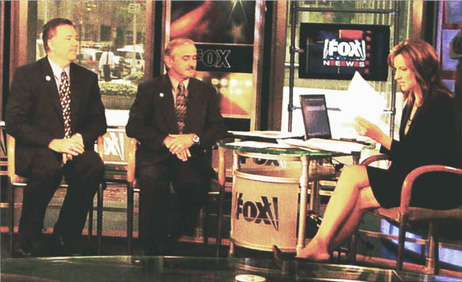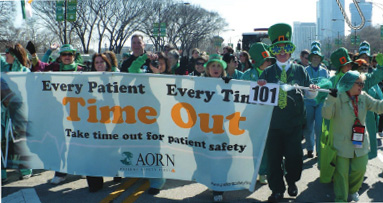The Story of the Time Out and Perioperative Nurse Advocacy
By: William Duffy, MJ, RN, CNOR, FAAN
Published: 6/12/2024
It has been 20 years since perioperative nurses across the country banded together to develop a strategy to prevent wrong-site surgery. At that time, I was the President of AORN, and I had the honor of organizing and leading this effort that resulted in a significant change in perioperative practice around the world with the development of the AORN Time Out Tool Kit and National Time Out Day on June 21, 2004. Here is a brief history.
The Problem
In 2002, the National Quality Forum (NQF) developed a list of medical errors that should not occur.1 Wrong-site surgery was included in the list. Unfortunately, the NQF list only identified the medical errors. The list did not provide solutions to prevent these errors from happening. This meant that each health care organization developed their preferred method to prevent these errors from occurring. For example, there were organizations that decided to put a mark on the limb that needed surgery, and there were organizations that decided to put a mark on the limb that did not need surgery. The lack of a unified process across health care systems meant that wrong-site surgery continued to occur. It was clear that someone or some group in perioperative practice needed to step up with a plan to solve this problem.
The Solution
As President of AORN, I approached the AORN Board of Directors with the premise that, as perioperative nurses, we have great influence on the practices in the operative setting. Our Standards and Recommended Practices guided the care we delivered, so it seemed fitting that we should try to develop a standardized process to ensure we identified the correct patient, procedure, and site before we began an operative procedure. The AORN Board agreed, and our journey to develop time out began.
Developing the Time Out Tool Kit
A team of AORN staff and volunteers contacted Dr. Lucian Leape, who was a physician and a professor at the Harvard School of Public Health, known for his work on patient safety issues.2 Dr. Leape agreed to collaborate with us, and we developed the AORN Time Out Tool Kit. But developing the tool kit was the easy part. The next step was to get folks to follow the tool kit. We needed marketing and partnership strategies.
We decided to have individual conversations with key players in the perioperative arena. First, we approached the Joint Commission on Accreditation of Healthcare Organizations (JCAHO), known today as The Joint Commission. JCAHO appreciated our vision and endorsed the tool kit. We then approached the American College of Surgeons (ACS), the American Society of Anesthesiologist (ASA), the Association of Surgical Technologists (AST) and the American Association of Nurse Anesthetists (AANA). Each of these conversations were delicate as we did not want to make these organizations feel we were dictating a nurse-led protocol, but instead we were working to develop a partnership with them to address a serious patient safety issue. The partnership strategy worked, and each organization agreed to sign on to the time out tool kit process.
Once we had the major stakeholders in the perioperative process on board, I approached the AORN Board with a significant ask. I wanted to tap into our financial reserves to invest several hundred thousand dollars for a professionally led marketing campaign to get word of the time out process into the public’s awareness. There were some intense discussions and crucial dialogue surrounding the fact this would be a big spend and we wondered if we would get a return on the investment. Ultimately, the Board agreed, and we took a chance that people would be interested in hearing about a nurse-led effort to eliminate wrong-site surgery. We felt this was necessary, because nursing history is full of great ideas that do not get traction because folks are not aware of the resource. I commend that AORN Board for believing in the power of nurse advocacy and taking the risk to invest in an action that would save countless lives.
We hired a public relations firm and developed a marketing plan that had two distinct action steps. First, we went big and declared a National Time Out Day and prerecorded a news story where a reporter interviewed me. We then purchased satellite time where our interview was uploaded to a news satellite so television stations could download the story. In addition, we reached out to the CBS Morning Show, Fox News, the Wall Street Journal, USA Today, the Associated Press, and National Public Radio (NPR). I spent the week traveling the country doing interviews to educate the public on the need for the time out and to ask for their help in making sure it happened if they were having surgery. The response was amazing, and our news story was the number one downloaded news story the week of National Time Out Day!

President Bill Duffy (left) and Tom McLaren, Tallahassee FL, appear with Fox News anchor Bridgitte Quinn to promote National "Time Out" Day.
While we were educating the public, we dedicated time to educate and engage with our AORN members on the time out process. Each AORN national board member did a series of chapter visits to educate the members on the tool kit and the resources we created to help them implement the process at their organization. The AORN Board also received media training designed to help us help chapter leaders do interviews with their local news outlets. Finally, we sent a copy of the tool kit to every member and every hospital in the United States for free. This was important in that we felt we should not be charging folks for something that could improve the safety of the perioperative process.
The response was overwhelming. Not only did we change perioperative practice in the United States, but we changed practice around the world. Soon after National Time Out Day, we received requests for the tool kit from hospitals in Europe, Australia, and Asia and the tool kit was incorporated into the World Health Organization’s checklist.
Conclusion
The story of the Time Out Tool Kit is a tale about the power that nurses have to change the world. Colleagues, we can do anything we put our minds to. Please do not let anyone tell you that nurses do not have power to create change. Nurses have been creating change since Florence Nightingale, and we will continue to improve the health care system in the United States and the world. Happy 20th anniversary!

More than 150 AORN members from 14 states marched in Chicago's St. Patrick's Day parade in 2009.
References
- Never Events. Patient Safety Network. September 7, 2019. Accessed May 18, 2024. https://psnet.ahrq.gov/primer/never-events
- Lucian Leape. Wikipedia. Accessed May 18, 2024. https://en.wikipedia.org/wiki/Lucian_Leape
AORN Resources
Open access:
- National Time Out Day | AORN Blog
- William Duffy 2004 interview regarding Time Out Day
- Statement on National Time Out Day: The Joint Commission and the Association of periOperative Registered Nurses make time for time out | AORN Blog
- Joint Statement by AORN and The Joint Commission on Time Out Day | AORN Blog
- 3 Steps to Secure an Official Time Out Proclamation | AORN Blog
AORN members can access:
- Tips for Improving the Effectiveness of Time Outs - AORN Journal
- Guideline Quick View: Team Communication - AORN Journal
- Minimizing the Risk of Wrong‐Site Surgery - AORN Journal

